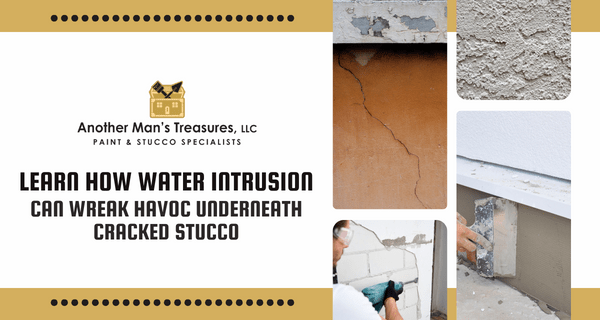The Havoc Wreaked by Water Intrusion Underneath Cracked Stucco
Water intrusion, especially underneath cracked stucco, can lead to a cascade of structural and aesthetic issues, emphasizing the importance of stucco maintenance and water intrusion prevention measures. Stucco, a construction material made of aggregates, binder, and water, is widely applied as a decorative coating for walls and ceilings and as a sculptural and artistic material. Though durable and aesthetically pleasing, stucco can crack and expose structures to water damage, leading to multiple problems, from mold growth to structural instability.
The Mechanics of Water Intrusion
When stucco cracks, water can seep into the walls, bypassing the protective barriers designed to keep moisture out. This intrusion is not just a superficial problem; it delves deep into the structural components of the building, creating an environment ripe for damage and decay. Prolonged exposure to water can lead to the degradation of wooden structures, metal components rusting, and the overall weakening of the building’s integrity.
The Downfall of Structural Integrity
The continuous presence of water within the walls can compromise the structural integrity of a building. When water infiltrates structural components like the wooden frame, it can lead to wood rot, which gradually weakens the structure. The long-term impact could be substantial, leading to the failure of structural components, and posing severe safety risks.
The Silent Growth of Mold and Mildew
Mold and mildew are fungi that thrive in damp, dark environments, making water-damaged walls an ideal breeding ground. They can propagate swiftly, affecting indoor air quality and causing a host of health problems, including respiratory issues, allergic reactions, and other illnesses. Mold remediation can be expensive and may require the removal and replacement of large sections of walls and insulation.
The Visual and Aesthetic Deterioration
Cracked stucco with water intrusion can manifest visual symptoms over time, such as staining, bubbling, and peeling paint, diminishing the aesthetic value of the property. If left unattended, it can lead to unsightly structural components and deteriorate the building’s exterior appearance, affecting its overall value and appeal.
The Economic Repercussions
Addressing the impacts of water intrusion underneath cracked stucco is typically costly. The expenses involved in structural repairs, mold remediation, and aesthetic restoration can quickly accumulate. Early detection and intervention are crucial in mitigating the economic burden associated with water intrusion damage.
Proactive Prevention and Intervention
To avoid the detrimental effects of water intrusion:
- Regular Inspection:
Conduct routine inspections for any signs of stucco damage, such as cracks or bulges, and address issues immediately.
- Prompt Repairs:
Repair any damage promptly to prevent water from infiltrating the stucco and reaching structural components.
- Water-Resistant Barriers:
Install water-resistant barriers underneath the stucco to reduce the risk of water intrusion.
- Proper Installation:
Ensure that stucco is installed correctly, with adequate thickness and the right mix, to avoid premature cracking and deterioration.
- Ventilation:
Adequate ventilation is crucial to prevent the accumulation of moisture within the walls, reducing the risk of mold growth and structural damage.
- Professional Consultation:
Seek professional advice to assess the property’s vulnerability to water intrusion and to implement preventive measures effectively.
AMT’s Thoughts
Water intrusion underneath cracked stucco is a silent destroyer, capable of wreaking havoc on the structural integrity, aesthetic appeal, and safety of buildings. Proactive preventive measures, regular inspections, and prompt repairs are essential in preserving the longevity and value of properties. By learning about the risks and understanding the importance of maintenance and intervention, property owners can protect their investments and ensure the safety and well-being of the occupants.

